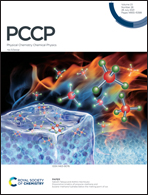Optical properties and energy transfer processes in Tb3+-doped ZnSe quantum dots
Abstract
Tb3+-Doped ZnSe quantum dots (QDs) with a Tb content in the range of 0.5–7% were successfully synthesized by a wet chemical method. X-Ray diffraction (XRD) and transmission electron microscopy (TEM) analyses revealed that the as-synthesized QDs had a zinc blende (ZB) structure with a particle size of approximately 4 nm. The effect of Tb-doping on the structure and optical properties of the ZnSe QDs was studied. The emission spectra and photoluminescence (PL) decay kinetics data confirmed the successful incorporation of Tb3+ ions into the ZnSe host. The PL spectra also revealed that the intensity of dopant emission was significantly enhanced owing to the energy transfer (ET) from the host emission. The efficiency of the ET process from the ZnSe host to Tb3+ ions and between Tb3+ ions and the nature of these interaction mechanisms were determined by applying the Inokuti–Hirayama and Reisfeld models. The features of the ligand field and the optical properties of Tb3+ ions in the ZnSe QDs were studied using Judd–Ofelt theory. The dependence of the chromaticity features of ZnSe:Tb3+ QDs on the Tb concentration was estimated by the chromaticity coordinates and correlated color temperature (CCT). The Tb3+-doped ZnSe QDs with visible, tunable, and very long lifetime emission have potential for practical applications such as biological labeling, photocatalysis, and white-LED devices.



 Please wait while we load your content...
Please wait while we load your content...